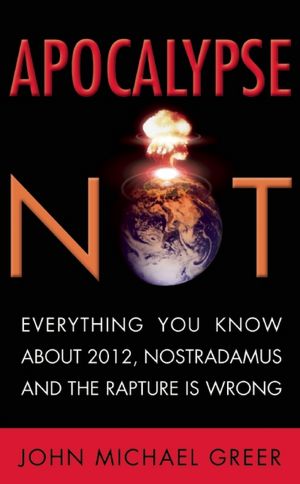New Agers are counting down the days until the
Mayan calendar ends in 2012. Evangelical Christians long for the Rapture.
Extropians dream of the Singularity, when computers will surpass human
intelligence and technology will transcend all limits. Doomers stockpile
freeze-dried food as they wait for civilization to crash and burn around them. What do they all have in common?
They’re all wrong.
For almost 3,000 years apocalypse prophecies have
convinced people all over the world that the future is about to give them the
world they want instead of the world they’ve got. John Michael Greer’s Apocalypse
Not is a lively and engaging survey of predictions about the end of the
world, along with the failed dreams and nightmares that have clustered around
them.
Have a look:
A strong case could be made for the idea that
storytelling is one of humanity’s oldest and most powerful technologies. As
soon as the extraordinary gift of human language finished emerging out of
whatever forgotten precursors gave it birth, hunters back from the chase and
gatherers returning with nuts and tubers doubtless started describing their day’s
experiences in colorful terms, and their listeners picked up more than a few
useful tips about how to track an antelope or wield a digging stick: the glory
of the impala’s leap and the comfortable fellowship of gatherers working a
meadow together wove themselves into the stories and the minds of the audience,
and helped shape their experience of the world. Stories still do that today, whether
they’re woven into the daily news, dressed up as religious or secular ideology,
or in their natural form as stories one person tells another.
Some of these stories are very, very old. Most of
the stories that people nowadays call “mythology,” in particular, have roots
that run back far into the untraceable years before anybody worked out the
trick of turning spoken words into something more lasting. Read through the
myths of every culture and you’ll find certain themes repeated endlessly: stories
of a golden age or paradise back in the distant past when things were much
better than they are now; stories of a worldwide flood from which a few
survivors managed to escape to repopulate the world; stories of terrible
monsters and the heroes or heroines who killed them; stories of heroes or
heroines of a different kind, who died so that other people might have a more
abundant life—all these and others are part of the stock in trade of myth
around the world, shared by peoples whose ancestors, at least until modern
times, had no contact since the end of the last Ice Age.
Some modern theorists, starting from this evidence,
have argued that these core themes and the stories based on them are somehow
hardwired into the human brain. This may or may not be true—the jury’s still
out on the question— but it’s definitely the case that most of the themes of mythology
appear on every continent and in every age. If they were invented, the event
happened so long ago that no trace remains of the inventor or the time and
circumstances of the invention.
The apocalypse meme is one of the few exceptions. Hard
work by a handful of perceptive scholars, most notably historian of religions
Norman Cohn, has traced it back to a specific place, time, and person. The
place was the rugged region of south central Asia that today is called Iran,
the time was somewhere between 1500 and 1200 BCE, and the person was
Zarathustra, the prophet of the religion now called Zoroastrianism.


No comments:
Post a Comment